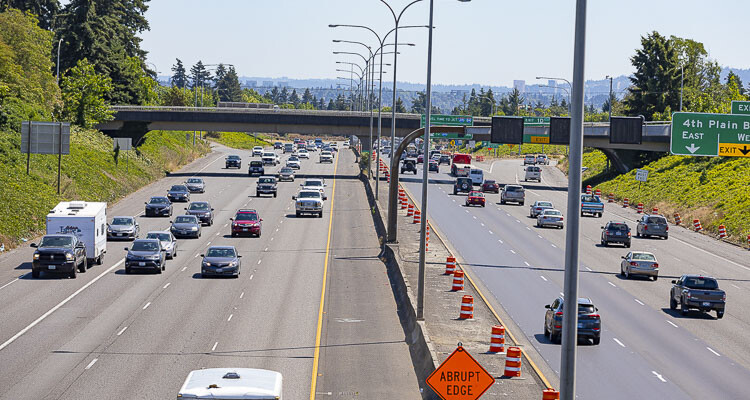
The annual report measures highway performance based on 13 different categories
Brett Davis
The Center Square Washington
Washington state ranks 46 out of 50 states for highway performance and cost-effectiveness, according to a Thursday report from the Reason Foundation.
The annual report measures highway performance based on 13 different categories, including urban and rural pavement condition, deficient bridges, traffic fatalities, spending per mile, and administrative costs per mile of highway.
“To determine relative performance across the country, state highway system budgets (per mile of responsibility) are compared with system performance, state by state,” the report’s introduction explains. “States with high ratings typically have better-than-average system conditions (good for road users) along with relatively low per-mile expenditures (good for taxpayers).”
Washington’s worst rankings are in capital and bridge spending per mile (No. 50) and maintenance spending per mile (No. 50).
The state’s best rankings are in the rural fatality rate (No. 4) and the urban fatality rate (No. 6).
“Washington ranks in the bottom 10 nationally in six of the report’s 13 metrics,” Reason’s individualized report for Washington notes. “The state’s costs are disproportionately high and the biggest driver of its poor overall rankings.”
Those high costs are reflected when compared to neighboring states.
“Washington’s 2.09 capital and bridge disbursement per lane ratio is highest in the country, 1.6 times higher than peer state Oregon’s ratio and two times higher than peer state Colorado’s ratio,” the Washington-specific report states. “Washington’s 3.36 maintenance disbursement ratio per lane-mile is the highest in the country, three times higher than Oregon’s ratio and 2.3 times higher than Colorado’s ratio.”
Washington state’s overall 46th ranking stands in contrast to Oregon’s 37th ranking and Idaho’s No. 34 position on the list.
“While it may be challenging for Washington to reduce its spending, if the state could improve its pavement quality to the national average, it would move up in the overall rankings,” advised Baruch Feigenbaum, lead author of the report and senior managing director of transportation policy at Reason Foundation. “As is, the state has the worst of both worlds: high spending and poor roadways.”
The Center Square reached out to the Washington State Department of Transportation, or WSDOT, for comment on the study’s findings pertaining to Washington.
“WSDOT faces outstanding pavement and bridge maintenance needs across the state resulting from years of not enough preservation funding,” WSDOT spokesperson Christina Werner said in an email. “As you know, the transportation budget is established by the Washington State Legislature and we continue to work with them to prioritize appropriation sufficient to meet our maintenance and preservation needs.”
Workers are doing their best to keep up roads with the resources they have, she continued.
“For roadways, our regional maintenance crews have extended surface life by striving to keep pavements in fair or better condition based on the resources allocated to us,” Werner said. “We prefer to begin the rehabilitation process to protect the pavement structure and manage pavement at the lowest life-cycle cost when it is in fair condition, but that has not always been possible given current funding.”
She brought up the nearly $17 billion, 16-year “Move Ahead Washington” transportation package that passed the Legislature last year.
“The 2022 Move Ahead Washington transportation funding package was a good down payment on our preservation needs, but it does not resolve the years of underinvestment,” Werner said. “For the first time in many years, we’re spending more than half of what we know we need to spend on maintenance and preservation – but that still leaves an annual $350 million deficit for roadway needs alone, and $830 million for all agency assets.”
She concluded, “Even with this funding package, our roads, bridges, ferries, trains, transit and facilities (including vehicles, buildings, IT and communications systems) still need significant amounts of additional funding to protect the investment the taxpayers have made in this infrastructure. We continue to share that story and those needs while doing the work we can with current available funding.”
Charles Prestrud, director of the Coles Transportation Center at the Washington Policy Center, a free-market think tank, and a former WSDOT planning manager for King and Snohomish counties, offered some backup to what Werner said.
“WSDOT maintenance personnel are highly skilled and good at what they do, but for the last dozen years WSDOT hasn’t done nearly enough of that work to keep up with system wear and deterioration,” he emailed The Center Square. “That is because neither the Legislature nor the governor made it a priority. Funding was significantly increased in last year’s transportation budget, and in the budget the Legislature is poised to adopt this year, but it will take years for the actual work to get done. Even that increased funding will not be enough to cover the extensive backlog of maintenance and preservation work.”
The pandemic is also a factor.
“Highway preservation and maintenance work fell further behind during the COVID pandemic,” Prestrud said. “This was exacerbated by an emergency order mandating vaccination for WSDOT employees. As a result, hundreds of staff were dismissed or forced to retire and WSDOT was unable to complete preservation projects. WSDOT is still short-staffed for highway maintenance work.”
Washington’s No. 46 ranking represents a four-spot decline from Reason’s previous study.
This report was first published by The Center Square Washington.
Also read:
- Expect delays on northbound I-5 near Ridgefield through May 9Northbound I-5 travelers near Ridgefield should expect delays through May 9 as crews work on improvements at the Exit 14 off-ramp to support future development.
- 6-cent gas tax hike central to new transportation deal in WA LegislatureA proposed 6-cent gas tax hike is central to a transportation funding deal under negotiation in the Washington Legislature, aimed at raising $3.2 billion over six years.
- Letter: C-TRAN Board improper meeting conductCamas resident Rick Vermeers criticizes the C-TRAN Board for misusing parliamentary procedure during a controversial vote on light rail.
- Opinion: TriMet’s ‘fiscal cliff’ a caution for Clark County taxpayersRep. John Ley warns that Portland’s financially troubled TriMet transit system could pose major risks to Clark County taxpayers as the I-5 Bridge replacement moves forward.
- Travel Advisory: Expect daytime delays on northbound I-5 near Woodland for guardrail repairs, April 18WSDOT will close the left lane of northbound I-5 near Woodland on Friday, April 18, to repair guardrail and improve driver safety.









